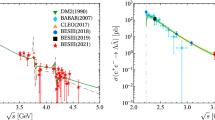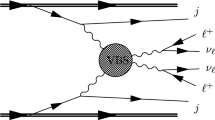Summary
A covariant formula for the electron energy spectrum of a fermion emitted in the 4-fermion decay is deduced from the standardV–A interaction. The masses of all these fermions are parametrized. The electron energy spectra of the muon, neutron and hyperon decays are obtained in the standard calculus, but from one general formula and without any approximations with respect to the masses of decay products, as compared to the mass of a decaying particle. A part ofFriedberg’s (1) results is rederived. It is pointed out why the electron energy spectrum of muon decay is described correctly by zero-order approximation with respect toz=\({{\left( {m_{\nu _\mu }^2 + m_{\nu _\beta }^2 } \right)} \mathord{\left/ {\vphantom {{\left( {m_{\nu _\mu }^2 + m_{\nu _\beta }^2 } \right)} {\left( {m_\mu ^2 + m_e^2 - 2m_\mu E} \right)}}} \right. \kern-\nulldelimiterspace} {\left( {m_\mu ^2 + m_e^2 - 2m_\mu E} \right)}}\). From an exact formula for the electron energy spectrum of the neutron β-decay (in the case of the standardV–A interaction) the « phase space » electron energy spectrum is found as a zero-order approximation with respect to the terms ∼m e /M (m e ,M=electron and nucleon masses). This approximation should be valid as long as the experimental accuracies will be ΔE/E⩾m e /M and Δ(C A /C V ) ⪞m e /M (C A ,C V =axial-vector and vector coupling constants). Any deviations, of order of magnitude larger thanm e /M, of the electron energy spectrum of neutron decay from the « phase-space » form cannot be explained by the kinematical and radiative (2) corrections only. These corrections are of almost the same order of magnitude as the corrections caused by « weak Gell-Mann magnetism » (3). The approximation for the electron energy spectra of hyperon decays is discussed in the order [(A–B)/B]4 (A=decaying hyperon mass,B=heavy decay product mass). Some covariant integrals are generalized to the arbitrary masses of the corresponding four-momenta involved there.
Riassunto
Dalla interazioneV–A normale si deduce una formula covariante per lo spettro d’energia elettronico di un fermione emesso nel decadimento a 4 fermioni. Le masse di tutti questi fermioni sono espresse in forma parametrica. Si ottengono gli spettri d’energia elettronici dei decadimenti muonici, neutronici ed iperonici col calcolo normale, ma da una sola formula generale e senza alcuna approssimazione rispetto alle masse dei prodotti di decadimento, in confronto alla massa della particella che decade. Si deduce nuovamente una parte del risultato diFriedberg (1). Si mette in rilievo il motivo per cui rispetto az=\({{\left( {m_{\nu _\mu }^2 + m_{\nu _\beta }^2 } \right)} \mathord{\left/ {\vphantom {{\left( {m_{\nu _\mu }^2 + m_{\nu _\beta }^2 } \right)} {\left( {m_\mu ^2 + m_e^2 - 2m_\mu E} \right)}}} \right. \kern-\nulldelimiterspace} {\left( {m_\mu ^2 + m_e^2 - 2m_\mu E} \right)}}\), in approssimazione di ordine zero, lo spettro d’energia elettronico del decadimento muonico è correttamente descritto. Da una formula esatta dello spettro d’energia elettronico del decadimento beta del neutrone (nel caso della interazioneV–A normale) si trova lo spettro d’energia elettronico nello spazio delle fasi come un’approssimazione di ordine zero rispetto ai termini ∼m e /M (m e ,M=masse dell’elettrone e del nucleone). Questa approssimazione dovrebbe essere valida sinchè le esattezze sperimentali sono ΔE/E ⩾m e /M e Δ(C A /C V ⪞m e /M (C A ,C V =costanti di accoppiamento assiale-vettoriale e vettoriale). Nessuna deviazione, di ordine di grandezza maggiore dim e /M, dello spettro di energia elettronico del decadimento neutronico dalla forma dello spazio delle fasi può essere spiegata con le sole correzioni cinematica e radiativa (2). Queste correzioni hanno circa lo stesso ordine di grandezza delle correzioni causate dal « magnetismo debole di Gell-Mann » (3). Si discute l’approssimazione di ordine [(A – B)/B]4 (A=massa dell’iperone che decade,B=massa del prodotto di decadimento pesante) degli spettri d’energia elettronici dei decadimenti iperonici. Si generalizzano alcuni integrali covarianti alle masse arbitrarie dei corrispondenti quadrimomenti ivi interessati.
Similar content being viewed by others
References
R. Friedberg:Phys. Rev.,129, 2298 (1963).
Nguyen Van Hieu andYa. A. Smorodinsky:Žurn. Ėksp. Teor. Fiz.,44, 1628 (1963).
S. M. Bilenky, G. M. Ryndin, Ya. A. Smorodinsky andHo Tso-Hsiu:Žurn. Ėksp. Teor. Fiz.,37, 1758 (1959).
Seee.g. N. Cabibbo:Phys. Rev. Lett.,10, 531 (1963).
J. Bahcall andR. B. Curtis:Nuovo Cimento,21, 422 (1961).
S. Śniegocki:Nuovo Cimento,27, 536 (1963).
A. M. Baldin, V. L. Goldansky andI. L. Rozental:Kinematics of Nuclear Reactions (Moskva, 1959), p. 92, in russian.
W. H. Barkas, W. Birnbaum andF. M. Smith:Phys. Rev.,101, 778 (1956).
M. M. Block, E. Fiorini, T. Kikuchi, G. Giacomelli andS. Ratti:Nuovo Cimento,23, 1114 (1962).
R. J. Plano:Phys. Rev.,119, 1400 (1960).
Comparee.g. C. S. Wu:Theoretical Physics in the Twentieth Century (New York, 1960), p. 256.
C. P. Enz:Nuovo Cimento,6, 250 (1957).
J. J. Sakurai:Phys. Rev. Lett.,1, 40 (1958).
J. R. Pruett:Phys. Rev.,73, 1219 (1948).
E. J. Konopinski:Ann. Rev. Nucl. Sci.,9, 99 (1959).
L. B. Okun: JINR Preprint P-833 (Dubna, 1961), p. 93;Weak Interaction of Elementary Particles (Moskva, 1963), p. 71, in Russian.
J. C. Pati:Thesis, University of Maryland, Technical Report No. 193, vol.2 (1960), p. 253.
L. Egardt:Nuovo Cimento,27, 368 (1963).
J. D. Jackson:1962 Brandeis Lectures, vol.1 (New York, 1963), p. 393.
K. Nagy:Aeta Phys. Hung.,17, 163 (1964).
Author information
Authors and Affiliations
Rights and permissions
About this article
Cite this article
Śniegocki, S. On the electron energy spectra of theV–A interaction. Nuovo Cim 33, 55–63 (1964). https://doi.org/10.1007/BF02734063
Received:
Published:
Issue Date:
DOI: https://doi.org/10.1007/BF02734063




